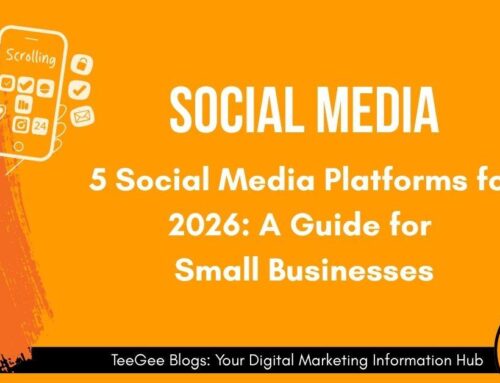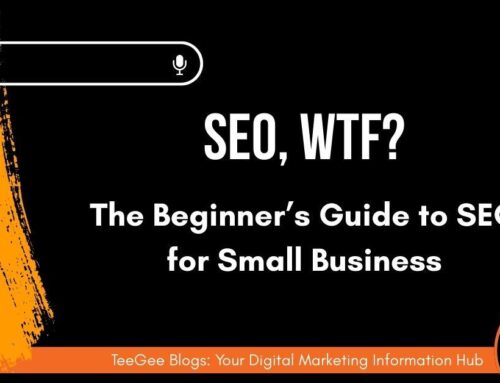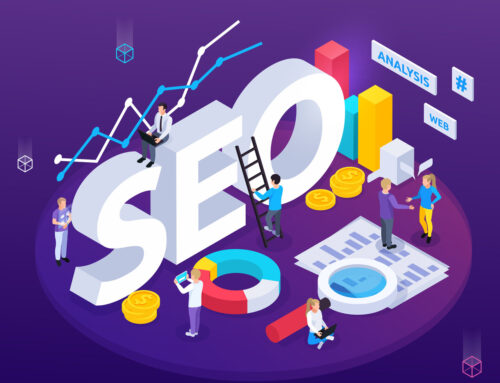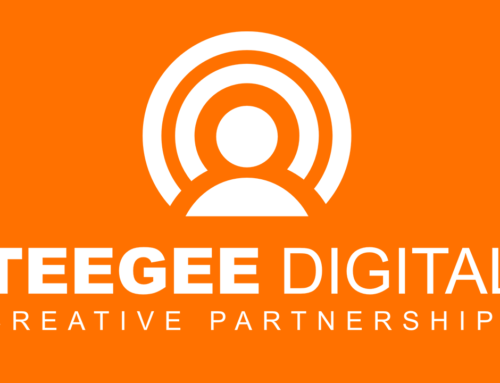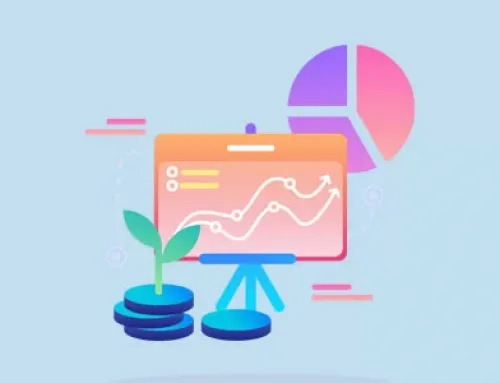As more of the tools we rely on daily implement AI features, AI is reshaping everything we do including how we search online.
No matter if you’re pro or anti-AI, it’s clear that AI is here to stay, meaning businesses must adapt their SEO strategies to work with generative searching capabilities.
If you want to keep your business appearing at the top of Google, you’ll need to meet the challenges of Generative Engine Optimisation (GEO).
What Changes Are Google Making to Searches?
What do you do when you’re watching TV and can’t remember an actor’s name? Or when your car makes a funny sound? Or when you want to find a new restaurant?
You head straight to Google!
Google’s purpose has always been to provide information. To get better at providing the information, Google has a continual development process of adding new features and upgrading existing ones – this includes leveraging AI in Google search functions.
What AI Features Have Google Implemented?
Whilst AI might seem like a new feature, Google have been implementing machine learning into their searches for decades.
In 2001, Google launched a spelling corrector – their first machine learning integration into their search function – just 3 years after their launch in1998. Although we think of AI as being new, this simple spelling device was an early form of machine learning, able to predict what searches meant to say even if words where mistyped or incorrectly spelled and display relevant results regardless of user error. AI in Google searches aren’t new; they’ve been around for most of Google’s lifespan.
Over the years, Google has remained at the forefront of AI implementation, leveraging AI to improve their search functions, but until now it’s always been behind the scenes. From Google Translate to MUM (Google’s advanced search model) every new feature Google creates is designed with one purpose in mind: to make Google better at finding you the information you want.
The quicker you can access relevant information, the better!
To that end, you might’ve noticed a new feature on your Google searches over the past few months – Google’s new AI overviews. But what are they, and what Google’s AI overviews mean for SEO?
What is Google’s New AI Overview Feature?
Google’s new AI overview feature is a condensed version of the search results. It appears at the top of the page but only for some searches, normally when you’ve asked a complex question rather than an informational search.
It works by pulling together information from multiple sources of across the web, collating data from several websites to give users a quick and concise answer without the user needing to search through several sites to find the answers.
Think of it like this:
Imagine you’re Googling how to service your own car. You want to carry out an oil change and replace the coolant. One site might tell you how to carry out an oil change, but not how to replace coolant. A different site might tell you how to replace the coolant but not perform the oil change. This means you need to visit at least two different sites to get an answer to one question.
Google’s new AI overview feature aims to remove problems like this by pulling information from both sites and assembling it all into one single consolidated answer.
As you can see, it references a number of web pages (shown in the top right-hand corner of the overview). When we breakdown this website list, we can see reputable sites like the RAC and Kwik Fit, but AI can also draw information from less reliable sites like Reddit.
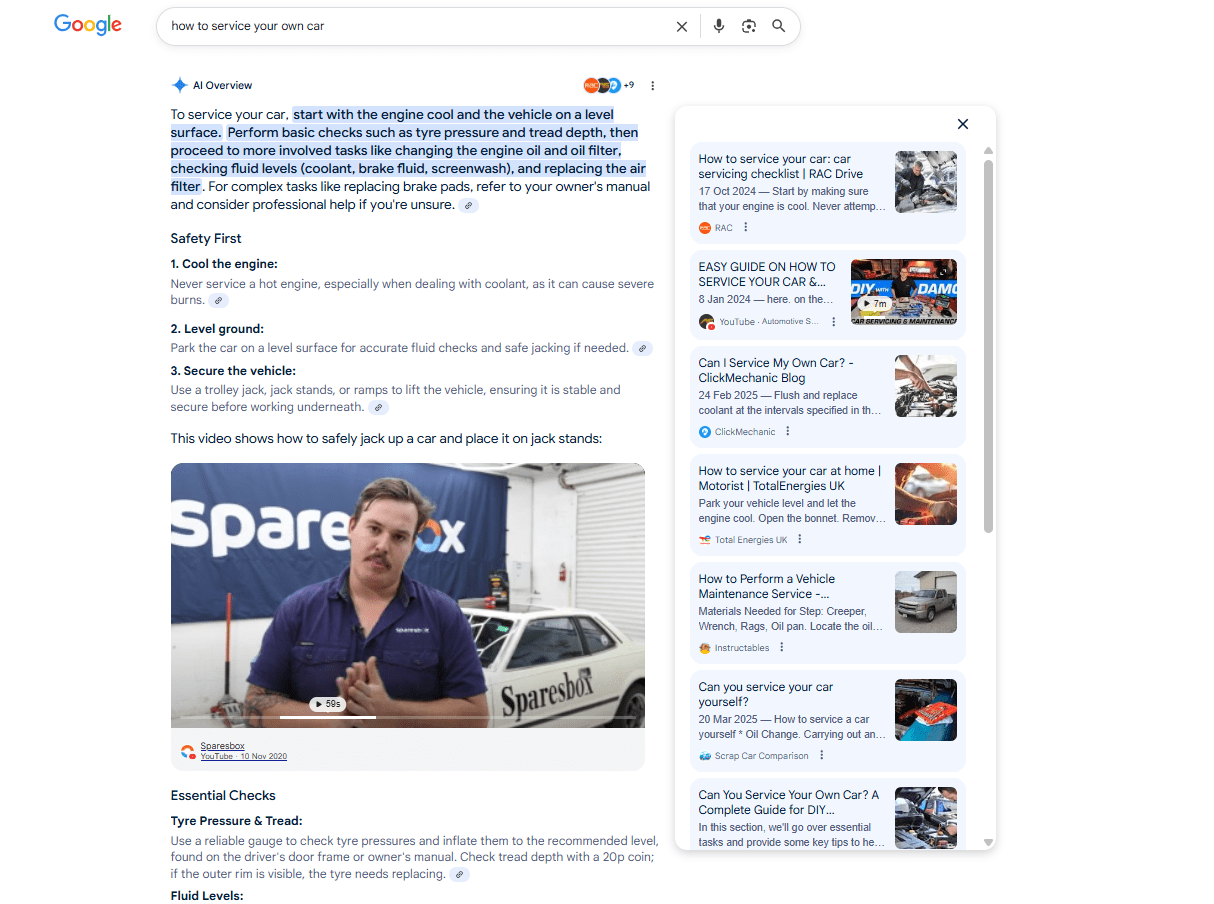
Can Google’s AI Overviews be Trusted?
In short, no. Google’s AI overviews come from multiple sources across the internet, and those sources may not always be correct – if several sources had misinformation, the AI overview would repeat it.
It’s important to remember that what we call generative AI is not true intelligence, it’s a Large Language Model (LLM) based on machine learning. AI can recognise patterns and repeat them, but it doesn’t have any critical reasoning abilities like a human. As humans, we can recognise if something sounds wrong, but AI models can’t (at least, not yet).
Whilst work is being done to make AI overviews as accurate as possible, they can still contain inaccuracies. This is why Google’s AI overviews should only be used as a starting point before moving to other websites for deeper, more reliable information.
Always fact check AI searches, no matter what model you’re using.
Remember: AI has been known to make mistakes and even fabricate false information.
What Do Google’s New AI Overviews Mean for my SEO?
Google’s new AI overview feature presents a significant challenge for SEO, especially for small businesses, but they also offer significant opportunities.
With AI overviews providing the information users are looking for right at the top of the page, one challenge is the possibility of reduced website clicks. When information searched for is displayed right at the top of the page, users aren’t going to keep searching if they’ve already found out what they’re looking for. This means you’re less likely to have people scrolling down and clicking on your link to your website to find organic search results.
You may also have featured snippets, an alternative question (“people also ask”) section, and recommended videos in addition to the AI overview.
This means your content might not appear on the SERP until almost halfway down the page!
After the AI overview, you may also have sponsored content – this is where the site owner has paid for a page to appear in the top spot to get more clicks.
For organic SEO this creates one major problem: people won’t scroll that far down the page to find what they’re looking for. This results in far less organic traffic, as users may struggle to find your site amongst the amount of content Google presents at the top of the SERP, meaning lower numbers of visitors and smaller CTRs.
Whilst this presents a problem, it also offers an opportunity: if you can make your website appear in the AI overview, your website will be at the very top of Google!
SEO is no longer the name of the game, instead, it’s GEO (Generative Engine Optimisation)!
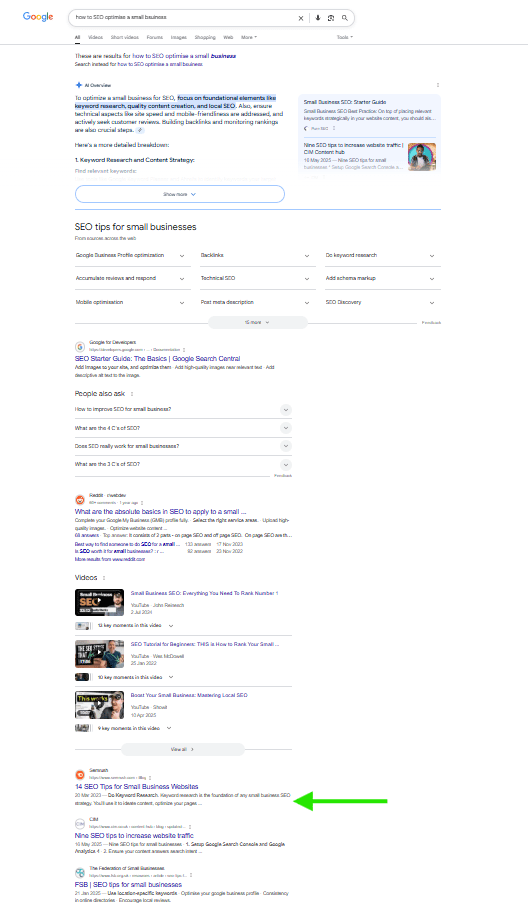
Your site might be more than halfway down the SERP, even if you rank #1 in organic SEO
How to Optimise Content for Google’s AI Overviews
Google’s AI overview pulls content from websites that are reputable. Remember, the purpose of the AI overview is to give people quick answers to their questions. If you can create valuable content that answers your user’s burning questions, you’re more likely to appear in the AI overview.
How to Create Valuable Content
The easiest way to do this is to think about your niche and put yourself in the shoes of someone looking to learn more about your business. What questions would they have? What would they like to know? What things are they likely to look for on Google about your business?
Write down a list of these questions and focus on creating content that answers them. The best way to do this is usually with blog posts.
Your answers should be authoritative, well-written, in-depth and provide value to your customers. What provides value to people provides value to SEO/GEO!
Keywords (which used to be the name of the game in traditional SEO) are still relevant for GEO, but now there’s an even greater emphasis on quality writing. Articles should be human, fun and easy to read. There’s also a greater emphasis on linking both internally on your own site and externally to other sites for research.
Content needs to be new and original, offering an alternative insight – even if it’s something someone else has written about in their blog, you will be able to write about it in a new way bringing your own unique experience to the subject. Never duplicate content or copy and paste from other sites, use them for research and put your own spin on them.
Unfortunately, creating valuable content isn’t enough. No matter how good your content is, if Google can’t understand it, it won’t display on the AI overviews.
How to Ensure Google Can Read Your Content
In addition to creating informational value, your content also needs to be organised and structured in such a way that is AI friendly and makes it clear to Google what your page is about.
As well as having valuable content, your site also needs to meet additional SEO requirements such as:
- Correct heading tags
- Fast loading times
- Keywords throughout the text
- No crawlability issues such as broken links
- Mobile optimisation (remember most people use their phones to search)
If you’re thinking that all of this sounds like a lot of work, you’re right. SEO and GEO are tough. So, if you can pay for a sponsored ad to get to the top, why not just do that instead? Surely that’s easier…
Why You Can’t Just Rely on Sponsored Content
SEO is a constantly changing landscape, even without factoring in the impact of AI and GEO. A successful SEO/GEO strategy requires regularly updating your site to keep up with changes – it’s a continual investment in your business.
You might be wondering what the point in organic SEO is if you can just pay for a sponsored spot to appear at the top.
Whilst it is true you can pay for a sponsored spot and appear at the top of Google; your site will still appear underneath the AI Overview.
Sponsored links cannot appear in AI overviews, meaning if you rely only on sponsored content, organic results in the AI overview will still appear above your paid post – in other words, you’re paying all that money to still appear further down the page!
Sponsored content also reaches a point of diminishing returns. There’s also the issue that many users don’t trust sponsored content as they know it’s been paid for.
Sponsored content can get more clicks onto your website and is especially valuable as a short-term strategy to get clicks quickly – however it can rapidly become expensive.
The best thing to do is leverage both sponsored content and SEO/GEO, creating a strategy that works for both traditional searches and AI.
Final Verdict
So, what’s the TLDR on all of this?
The simple answer is that yes, Google’s new AI feature can make it harder to get clicks for your small business, but that doesn’t mean that you need to revamp your entire SEO strategy just to fit the age of Generative AI.
Instead, it means is that your on-page SEO strategy is more important than ever, and that well-optimised, valuable and informative content is going to be the biggest asset for your business.
As it’s always been, SEO is a long-term strategy, and it can take time to see results. Whilst Google’s new AI overview feature may mean we have to work harder and increase competition, GEO optimisation and the chance to appear in Google’s AI overview presents a massive opportunity. Rather than seeing this as a threat to our SEO strategies, we should see this as a new chance to get even more traffic through the AI overview.
It can be hard to meet the new GEO challenges yourself, especially if you don’t have a background in SEO. That’s why we recommend working with an SEO service provider – our TeeGee Digital marketing team offers the full range of SEO services. We have specially trained SEO experts who can help develop content that puts your website at the top of searches.
Get in touch to discuss your GEO strategy below, or if you found this blog helpful, subscribe to our newsletter and get marketing tips straight to your inbox!
Get in touch
We offer a unique approach to web design, SEO & Digital Marketing.
Our team are experts in every field of digital marketing so, you can have a stunning, professionally designed website that gets you sales & leads!
If you have any questions, or would like to discuss your project with us, please use the form below and we will get back to you – usually within a couple of a hours.
Reference list
- Dean, J. (2012). Using large-scale brain simulations for machine learning and A.I. [online] Google. Available at: https://blog.google/technology/ai/using-large-scale-brain-simulations-for/.
- Google (2023). Google AI Principles. [online] Google AI. Available at: https://ai.google/responsibility/principles/.
- Google (2025). Google AI – Our AI journey and milestones. [online] Ai.google. Available at: https://ai.google/our-ai-journey/?section=stay_tuned [Accessed 11 Jun. 2025].
- Mueller, J. (2025). Top ways to ensure your content performs well in Google’s AI experiences on Search | Google Search Central Blog | Google for Developers. [online] Google for Developers. Available at: https://developers.google.com/search/blog/2025/05/succeeding-in-ai-search [Accessed 11 Jun. 2025].
- Nayak, P. (2021). MUM: A new AI milestone for understanding information. [online] Google. Available at: https://blog.google/products/search/introducing-mum/.
- Nayak, P. (2022). How AI powers great search results. [online] Google. Available at: https://blog.google/products/search/how-ai-powers-great-search-results/.
- Reid, E. (2025). AI in Search: Going beyond information to intelligence. [online] Google. Available at: https://blog.google/products/search/google-search-ai-mode-update/#ai-mode-search.
- Sutskever, I., Vinyals, O. and Le, Q.V. (2014). Sequence to Sequence Learning with Neural Networks. [online] arXiv.org. Available at: https://arxiv.org/abs/1409.3215.



